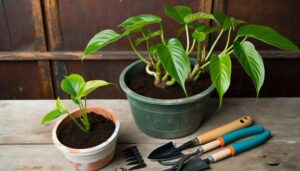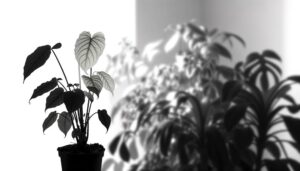Why Is My Philodendron Congo Drooping?
Philodendron Congo drooping is often due to watering issues, either overwatering causing root rot or underwatering leading to dehydration. Insufficient light disrupts photosynthesis, while temperature fluctuations between 65-80°F (18-27°C) can cause thermal stress.
Low humidity below 60% closes stomata, impeding leaf hydration. Poor soil drainage and nutrient deficiencies also play a significant role in plant health.
Addressing these environmental factors can help revive your plant. Proper care involves consistent watering, appropriate lighting, stable temperatures, high humidity, and nutrient-rich, well-draining soil.
Understanding these underlying causes ensures ideal plant health and strength through informed interventions.
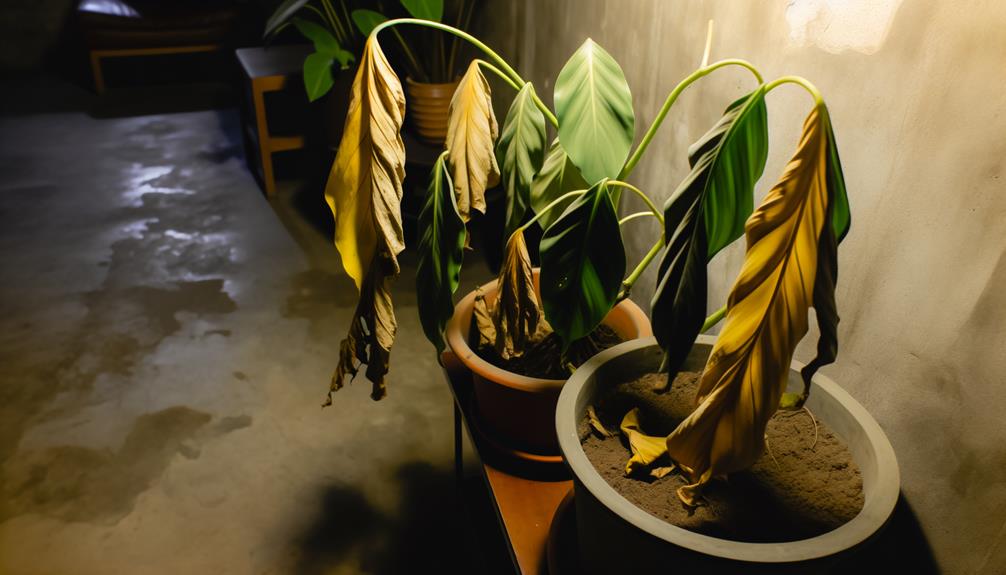
Key Takeaways
- Overwatering can lead to root rot and yellowing leaves, causing drooping.
- Insufficient light hinders photosynthesis, leading to drooping and leaf discoloration.
- Temperature stress from sudden changes or extremes causes cellular damage and drooping.
- Low humidity levels result in stomatal closure, leading to dehydration and drooping.
- Poor soil drainage leads to waterlogged conditions, root rot, and subsequent drooping.
Watering Issues
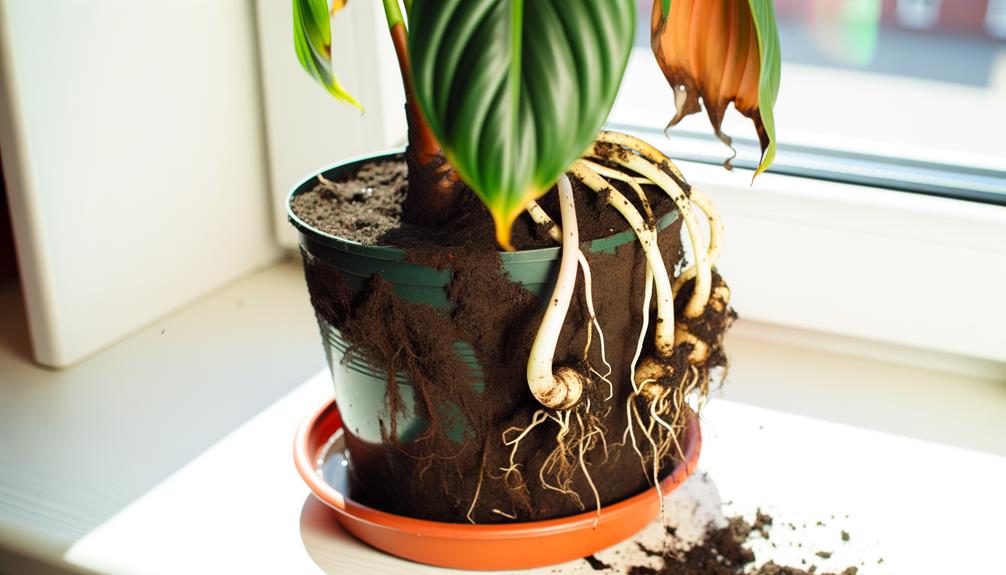
Improper watering practices are a primary cause of drooping in Philodendron Congo plants, often leading to symptoms such as yellowing leaves, root rot, and overall plant decline.
Overwatering saturates the soil, reducing oxygen availability to the roots and fostering pathogenic fungi, like Pythium and Phytophthora, which cause root rot. Conversely, underwatering deprives the plant of essential moisture, leading to dehydration and cellular turgor loss.
Evidence-based horticultural studies recommend maintaining a consistent watering schedule, ensuring the top 1-2 inches of soil dry out between waterings. Employing a well-draining potting mix and pots with adequate drainage holes can mitigate water retention issues.
Regularly monitoring soil moisture with a hygrometer can provide precise insights, helping to avert overwatering or underwatering scenarios.
Incorrect Lighting
Subpar lighting conditions are an important factor contributing to the drooping of Philodendron Congo plants, as insufficient light impedes photosynthesis, leading to weakened stems and chlorosis. This tropical plant thrives in bright, indirect light, which supports the synthesis of chlorophyll and overall plant vigor.
Several key indicators of incorrect lighting include:
- Leaf Discoloration: Yellowing or pale leaves suggest inadequate light.
- Stunted Growth: Reduced leaf size and slow growth rate indicate light deficiency.
- Leggy Stems: Extended, thin stems are a sign of the plant stretching for light.
- Leaf Drop: Premature leaf fall can result from prolonged low-light exposure.
- Burned Leaves: Direct sunlight can cause leaf scorching and brown spots.
Ensuring ideal lighting conditions is essential for the health and aesthetic appeal of Philodendron Congo.
Temperature Stress
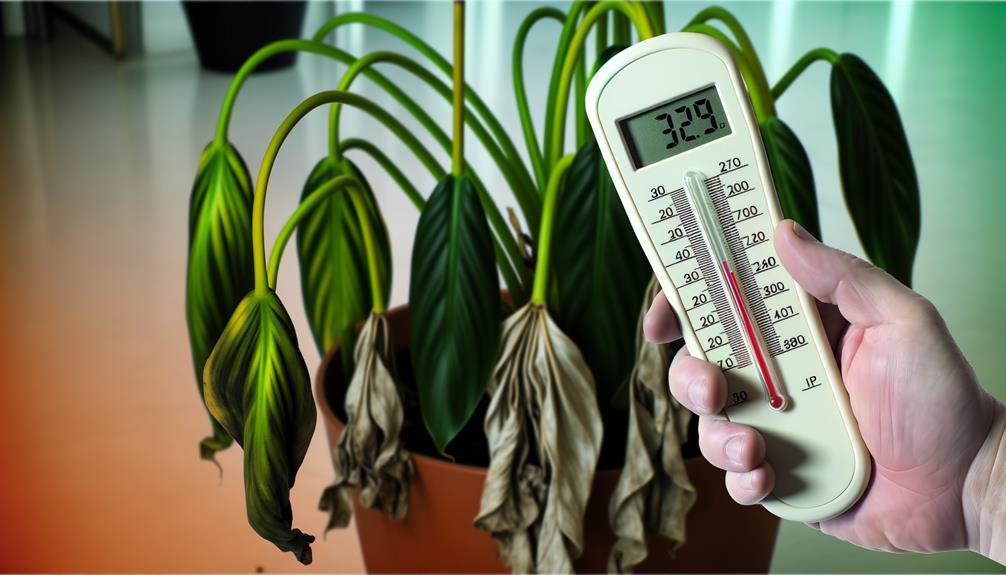
Temperature fluctuations can greatly impact the health of Philodendron Congo plants, leading to drooping and other stress symptoms. Best growth occurs within a stable temperature range of 65-80°F (18-27°C).
Exposure to temperatures below 55°F (13°C) can induce cellular damage, compromising photosynthetic efficiency. Conversely, temperatures exceeding 85°F (29°C) can exacerbate transpiration rates, leading to dehydration and subsequent wilting.
Sudden changes in temperature, caused by drafts or proximity to heating/cooling vents, can also induce thermal shock. Research indicates that temperature stress affects the plant's ability to maintain turgor pressure, a critical factor in leaf rigidity.
Consistently monitoring and maintaining an appropriate temperature range is essential for preventing the physiological stress that manifests as drooping in Philodendron Congo plants.
Humidity Levels
Maintaining ideal moisture levels is crucial for the physiological health of Philodendron Congo, as this tropical plant thrives in environments with relative moisture between 60% and 80%.
Insufficient moisture can lead to drooping, as the plant's stomata close to conserve water, hindering photosynthesis and nutrient uptake.
To ensure peak moisture, consider:
- Utilizing a humidifier to maintain stable moisture levels.
- Grouping plants together to create a microenvironment with higher dampness.
- Placing a water tray near the plant to increase ambient moisture through evaporation.
- Misting the leaves regularly to provide temporary moisture boosts.
- Monitoring with a hygrometer to track and adjust moisture levels accurately.
These interventions can mitigate drooping and support the plant's overall health.
Soil Quality
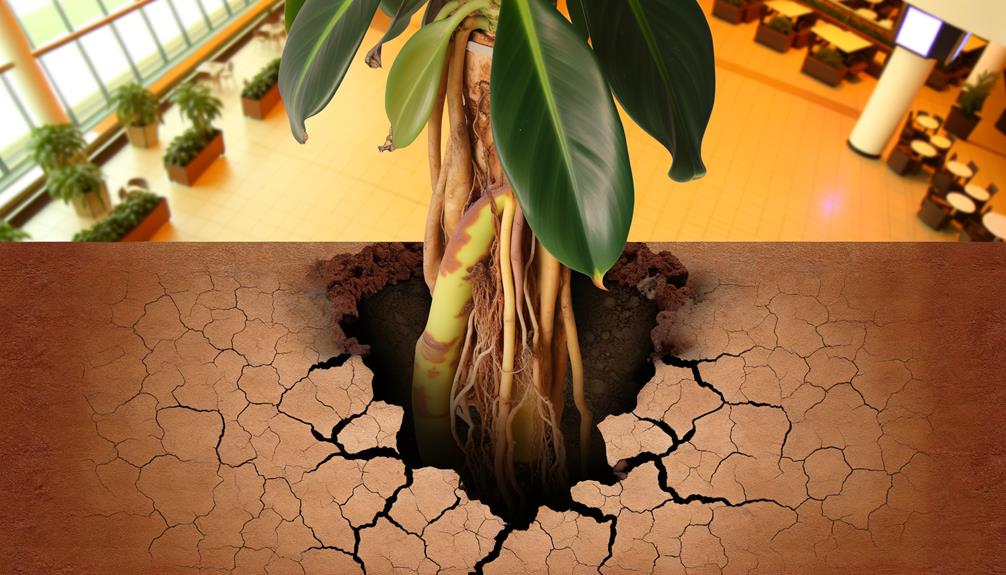
Soil quality plays a pivotal role in the health of Philodendron Congo. It is particularly important in its drainage capabilities and nutrient profile. Poor drainage can lead to waterlogged roots, causing hypoxic stress and subsequent drooping. Additionally, nutrient deficiencies can be identified through chlorosis and stunted growth, which may exacerbate the plant's declining vigor.
Poor Drainage Issues
Inadequate drainage often leads to waterlogged soil conditions, which can severely compromise the root health of Philodendron Congo, resulting in drooping foliage. The oxygen deprivation in saturated soil disrupts root function and can induce root rot, a fungal condition that deteriorates plant vitality.
To ensure best drainage:
- Soil Composition: Use a well-aerated mix, incorporating materials like perlite or orchid bark.
- Pot Design: Select containers with adequate drainage holes to prevent water accumulation.
- Watering Practices: Avoid overwatering; allow the top inch of soil to dry before rewatering.
- Elevated Planters: Consider using elevated trays to enhance drainage efficiency.
- Routine Checks: Regularly inspect the root system for signs of rot or fungal infection.
Proper management of these factors is essential to maintaining healthy, vibrant Philodendron Congo plants.
Nutrient Deficiency Signs
Beyond the issues of drainage, nutrient deficiencies in the soil can also greatly affect the health of Philodendron Congo, often manifesting as drooping leaves and stunted growth.
Essential nutrients such as nitrogen, phosphorus, and potassium play critical roles in photosynthesis, energy transfer, and overall cellular function. Deficiencies in micronutrients like iron, magnesium, and calcium can lead to chlorosis, necrosis, and weakened structural integrity. Evidence suggests that inadequate nutrient uptake disrupts osmotic balance, causing cellular turgor loss and subsequent leaf drooping.
Regular soil testing and balanced fertilization are essential to maintain the best nutrient levels. Employing a slow-release, well-balanced fertilizer can guarantee sustained nutrient availability, thereby supporting vigorous growth and preventing physiological disorders in Philodendron Congo.
Pest Infestation
Addressing pest infestation in Philodendron Congo is crucial, as pests such as spider mites, aphids, and mealybugs can severely compromise the plant's health by feeding on its foliage and stems, leading to drooping and other symptoms. These pests extract essential nutrients from the plant, causing stress and weakening its physiological processes.
Identifying and managing pest infestations involves:
- Spider mites: Tiny arachnids creating web-like structures on leaves.
- Aphids: Small, soft-bodied insects clustering on new growth.
- Mealybugs: White, cotton-like masses found on stems and leaf joints.
- Scale insects: Hard-shelled pests adhering to stems and undersides of leaves.
- Thrips: Slender insects causing silver streaks and deformed foliage.
Implementing targeted treatments, such as insecticidal soaps or neem oil, can mitigate these infestations effectively.
Nutrient Deficiency
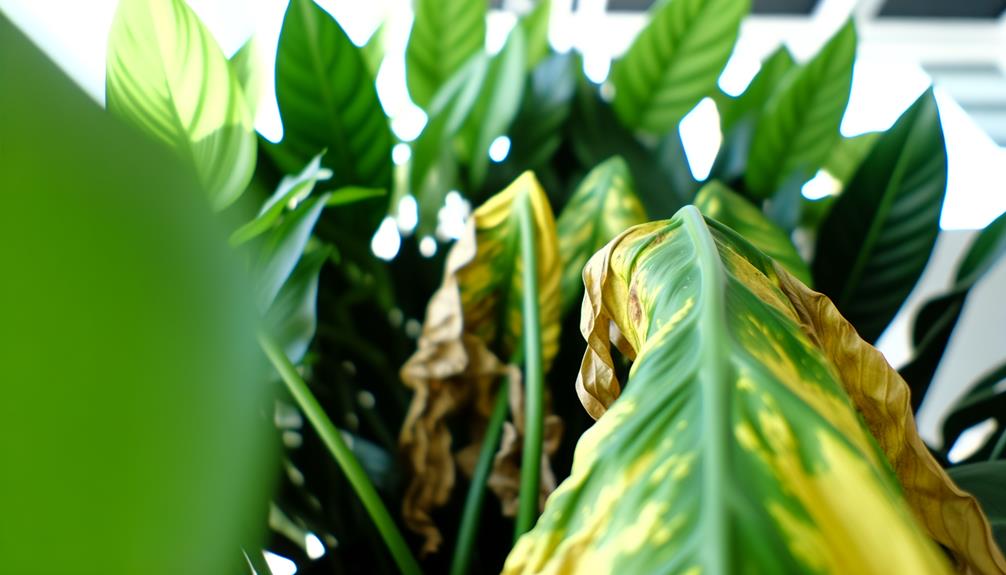
Nutrient deficiency in Philodendron Congo appears as chlorosis, stunted growth, and weakened structural integrity, demanding precise diagnosis and remediation to ensure peak plant health. Essential nutrients such as nitrogen, phosphorus, and potassium play pivotal roles in cellular functions and metabolic processes.
Nitrogen deficiency often results in yellowing leaves, while phosphorus shortage may cause dark, purplish foliage and reduced root development. Potassium scarcity can lead to leaf edge necrosis and poor resistance to environmental stressors.
Micronutrients like iron, magnesium, and calcium are equally vital; iron deficiency typically induces interveinal chlorosis, whereas magnesium and calcium deficits can cause leaf curling and tip burn, respectively.
Regular soil testing and balanced fertilization are indispensable practices to correct and prevent nutrient imbalances.
Root Health
Root health is essential in preventing Philodendron Congo from drooping, with root rot being a primary indicator of compromised integrity.
Overwatering can lead to anaerobic conditions, exacerbating root decay and impairing nutrient uptake.
Ensuring adequate soil aeration is vital to promote healthy root respiration and prevent pathogenic fungal proliferation.
Root Rot Symptoms
Philodendron Congo's susceptibility to root rot often manifests through symptoms such as yellowing leaves, stunted growth, and a foul odor emanating from the soil, indicating deteriorating root health. Recognizing these signs early is essential for plant recovery and overall health.
Key indicators of root rot include:
- Discolored Roots: Healthy roots are typically white or light tan, whereas rotting roots appear brown or black.
- Mushy Texture: Affected roots become soft and mushy due to cellular breakdown.
- Leaf Drop: Leaves may fall prematurely, signaling compromised root function.
- Wilting: Despite adequate watering, the plant wilts as nutrient uptake is impeded.
- Soil Fungus: Presence of mold or fungal growth on the soil surface suggests underlying root issues.
These symptoms require immediate intervention to prevent further deterioration.
Overwatering Consequences
Excessive watering remains one of the primary culprits for compromised root health in Philodendron Congo, often leading to hypoxic conditions that precipitate root rot. When the roots are submerged in waterlogged soil, oxygen availability diminishes, impeding cellular respiration and causing anaerobic conditions.
This environment fosters pathogenic fungi and bacteria, such as Pythium and Phytophthora species, which degrade root tissues. Initially, affected roots appear brown and mushy, progressively losing their functionality in nutrient and water uptake.
Over time, the plant exhibits systemic symptoms, including wilting and drooping, as the compromised root system fails to sustain its physiological needs. Hence, understanding the delicate balance of watering is essential for maintaining ideal root health and preventing the cascading effects of overwatering.
Soil Aeration Importance
Promoting sufficient soil aeration is vital for maintaining optimal root health in Philodendron Congo, as it enhances oxygen diffusion and prevents the development of anaerobic conditions. Inadequate soil aeration can result in root hypoxia, which hinders cellular respiration and nutrient absorption, ultimately leading to drooping.
To enhance soil aeration, take into account the following factors:
- Soil Composition: Use a well-draining mixture with perlite or orchid bark.
- Watering Techniques: Avoid excessive watering to prevent soil compaction and waterlogging.
- Choice of Container: Select containers with proper drainage holes.
- Aeration Devices: Utilize root aerators or soil probes to improve oxygen circulation.
- Regular Repotting: Replace soil periodically to preserve its structural integrity.
Following these guidelines promotes strong root systems, reducing instances of drooping.
Conclusion
To sum up, the drooping of Philodendron Congo can be attributed to several factors:
- incorrect watering
- insufficient lighting
- temperature stress
- low humidity
- subpar soil quality
- pest infestations
- nutrient deficiencies
- compromised root health
Addressing these issues with accuracy is crucial to restoring plant vigor. Overlooking these factors is like 'missing the forest for the trees,' potentially worsening the plant's decline.
Thorough, evidence-based care is crucial for the best health of Philodendron Congo.




